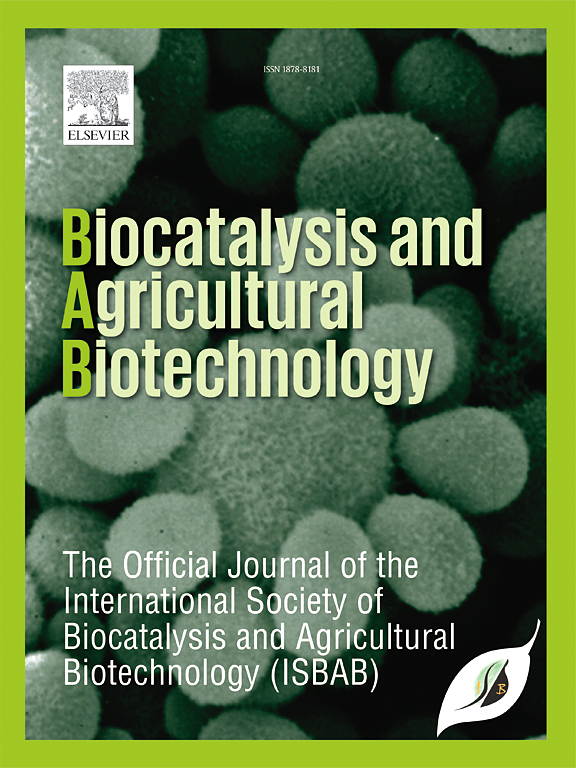大豆和芝麻对 MnS 纳米颗粒的生长、生化和抗氧化反应比较
IF 3.4
Q2 BIOTECHNOLOGY & APPLIED MICROBIOLOGY
引用次数: 0
摘要
锰是影响植物生长和发育的重要微量营养元素。这项研究证明,硫化锰纳米粒子(MnS NPs)是锰盐(MnSO4)的一种更好的替代品,可在体内条件下促进 Sesamum indicum 和 Glycine max 的生长。扫描电子显微镜(SEM)、傅立叶变换红外光谱(FTIR)、电离辐射X射线分析(EDX)和X射线衍射(XRD)显示,MnS NPs呈球形,纯度高,大小为 8 纳米。在土壤中添加 MnS NPs 可增加 G. max 和 S. indicum 的根和芽的长度、分枝数、生物量和蛋白质含量,增加的幅度与剂量有关,最高可达 40 毫克/千克。原子吸收光谱(AAS)显示,在 80 毫克/千克 NPs 的土壤中,G. max 根和芽的锰生物累积量分别为 103.8 毫克/千克干重和 50.4 毫克/千克干重;在 80 毫克/千克 NPs 的土壤中,S. indicum 根和芽的锰生物累积量分别为 127.6 毫克/千克干重和 84.6 毫克/千克干重。施用氮磷钾会导致抗氧化酶(SOD、POD)的活化和次生代谢物(总酚类和类黄酮)的合成,其作用与浓度有关。经 NPs 处理的植物提取物显示出较高的总抗氧化能力(TAC)、总还原力(TRP)和 DPPH 自由基清除活性。分层聚类分析表明,40 毫克/千克和 60 毫克/千克的土壤 NPs 可促进植物生长和生物碱的产生。结果表明,施用 MnS NPs 对植物的生化特征、酶和非酶抗氧化剂有剂量依赖性影响。因此,MnS NPs 可作为新型诱导剂,改善植物的生长和生物含量。本文章由计算机程序翻译,如有差异,请以英文原文为准。
Comparative growth, biochemical and antioxidative response of Glycine max and Sesamum indicum to MnS nanoparticles
Manganese is an important micronutrient that affects plant growth and development. This study proved that Manganese Sulfide nanoparticles (MnS NPs) are a better alternative to manganese salt (MnSO4) for the growth of Sesamum indicum and Glycine max under in vivo conditions. SEM, FTIR, EDX and, XRD revealed spherical, pure and, 8 nm size of MnS NPs. The addition of MnS NPs to the soil increased root and shoot length, number of branches, biomass, and protein contents in a dose-dependent manner up to 40 mg/kg in both G. max and S. indicum. Atomic Absorption Spectroscopy (AAS) showed bioaccumulation of Mn at 103.8 and 50.4 mg/kg DW in G. max root and shoot respectively at 80 mg/kg NPs soil and, 127.6 and 84.6 mg/kg DW in S. indicum root and shoot respectively at 80 mg/kg NPs soil. NPs application leads to the activation of antioxidant enzymes (SOD, POD) and the synthesis of secondary metabolites (total phenolics and flavonoids) in a concentration-dependent manner. The extract obtained from NPs treated plants showed higher total antioxidant capacity (TAC), total reducing power (TRP), and DPPH free radical scavenging activity. The hierarchical cluster analysis indicates 40 and 60 mg//kg soil NPs to be the stimulant of plant growth and alkaloid production. The results show that MnS NPs application influenced the plant biochemical profile, and enzymatic and non-enzymatic antioxidants in a dose-dependent manner. Therefore, MnS NPs can be novel elicitors to improve plant growth and biological contents.
求助全文
通过发布文献求助,成功后即可免费获取论文全文。
去求助
来源期刊

Biocatalysis and agricultural biotechnology
Agricultural and Biological Sciences-Agronomy and Crop Science
CiteScore
7.70
自引率
2.50%
发文量
308
审稿时长
48 days
期刊介绍:
Biocatalysis and Agricultural Biotechnology is the official journal of the International Society of Biocatalysis and Agricultural Biotechnology (ISBAB). The journal publishes high quality articles especially in the science and technology of biocatalysis, bioprocesses, agricultural biotechnology, biomedical biotechnology, and, if appropriate, from other related areas of biotechnology. The journal will publish peer-reviewed basic and applied research papers, authoritative reviews, and feature articles. The scope of the journal encompasses the research, industrial, and commercial aspects of biotechnology, including the areas of: biocatalysis; bioprocesses; food and agriculture; genetic engineering; molecular biology; healthcare and pharmaceuticals; biofuels; genomics; nanotechnology; environment and biodiversity; and bioremediation.
 求助内容:
求助内容: 应助结果提醒方式:
应助结果提醒方式:


